Adrian Collins's Blog, page 53
June 10, 2024
REVIEW: Daughter of Calamity by Rosalie M. Lin
Rosalie M. Lin’s debut, Daughter of Calamity is set in the glittering world of Shanghai in the 1920s. A cultural melting pot thanks to the influence of colonialism, the Jazz Age seems to have taken root in China. The setting is enjoying a burst in popularity, notably in Chloe Gong’s These Violent Delights. And just like Gong, Lin picks up on these cultural tensions, on a world where nothing is quite like it was only a few years earlier. Both these stories grow out of organised crime – but that is where the similarities end. Lin’s Daughter of Calamity follows Jingwen, a dancer in one of the night clubs, as she is drawn into the family business, as one might say.
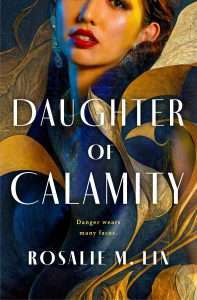 Jingwen’s story is one of self-determination more than oriented towards romance – and full of calculation and manipulation. It is dark just as much as it is glittering with the gold brought in by the setting. Girls, dancers, are losing bits of themselves. Jingwen is there when Huahua, one of her fellow dancers, is suddenly found without her lips. Only to see those precise lips on a white woman shortly after. Jingwen’s grandmother is a healer of sorts. One bound to the will of Wang Daojun, the leader of the Society of the Blue Dawn – who are colloquially known as “silverhands” due to their magical prosthetics. A reader may wonder if the two things are linked.
Jingwen’s story is one of self-determination more than oriented towards romance – and full of calculation and manipulation. It is dark just as much as it is glittering with the gold brought in by the setting. Girls, dancers, are losing bits of themselves. Jingwen is there when Huahua, one of her fellow dancers, is suddenly found without her lips. Only to see those precise lips on a white woman shortly after. Jingwen’s grandmother is a healer of sorts. One bound to the will of Wang Daojun, the leader of the Society of the Blue Dawn – who are colloquially known as “silverhands” due to their magical prosthetics. A reader may wonder if the two things are linked.
The central thread running through Daughter of Calamity is that power corrupts. No one who grows powerful is able to remain objectively good. Just as much as the players exploit power, power exploits them. Jingwen becomes her grandmother’s apprentice to bring her down – and Wang Daojun with her. She is motivated both intrinsically and externally. The Society of the Blue Dawn is just one of the many players in Shanghai’s underbelly. While they certainly take a prominent position within the story, it is always clear that they are just one part of a large web. Ultimately, it doesn’t make much of a difference who holds the power. They are all flavours of the same corruption trying to cement their position and willing to wager everything.
Daughter of Calamity is a dark and captivating tale. I loved reading a story focused on the moral ambiguity of its characters rather than romance. While there is a romantic element to it, it takes a back seat to the power dynamics examined. Jingwen is given space to discover herself. The story is pensive even while it is racing through dramatic events – and utterly enthralling. Daughter of Calamity is a different book to the one I thought I was going into, subverting expectations and eschewing simple expectations. It is a shimmering jewel of a debut and I look forward to reading more of Lin’s work.
Read Daughter of Calamity by Rosalie M. LinThe post REVIEW: Daughter of Calamity by Rosalie M. Lin appeared first on Grimdark Magazine.
June 9, 2024
REVIEW: Monstrum by Lottie Mills
Lottie Mills’ debut collection Monstrum is mind blowing. As the title hints, these stories explore what is monstrous, why we perceive someone as other. The collection is an open letter to society advocating for a re-examination of deeply entrenched expectations. Each story is haunting, thought-provoking and beautiful. And every single one is strong in its own right, unique but connected through an overarching theme of disability and the monstrous – because being different doesn’t mean worse or bad. Monstrum is on the very literary end of genre fiction, but worth the reader’s effort. Their appeal to a grimdark audience is clear in the stories’ examination of monstrosity, though it should be noted that Monstrum isn’t for every reader. While all of the stories in this collection are brilliant, I have picked out those that resonated especially well with me for further discussion.
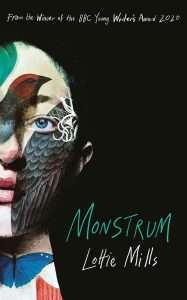 One of the stories that stuck with me most is “The Mirror”, where a young girl does the shopping for her supposedly monstrous mistress. Through small acts of kindness, she forges a relationship and throws any notion of monstrosity out the window. There is a sapphic element to it too, and a bittersweet ending. I was very impressed with how it dares to eschew the obvious ending – and how it manages to use the mirror theme as a cornerstone of the story.
One of the stories that stuck with me most is “The Mirror”, where a young girl does the shopping for her supposedly monstrous mistress. Through small acts of kindness, she forges a relationship and throws any notion of monstrosity out the window. There is a sapphic element to it too, and a bittersweet ending. I was very impressed with how it dares to eschew the obvious ending – and how it manages to use the mirror theme as a cornerstone of the story.
In 2020, Lottie Mills won the BBC Young Writers’ Award award for the opening story of this collection. “The Changeling” sticks with the reader long after they finish. It’s a slow, atmospheric story about physical change and deformity, about the expectations of normalcy. Mills’ clean prose and evocative writing stands out, as does her ability to take her time. At the centre of each story is a person, and they themselves are the point of the story. There is little convoluted plot, instead leaving the stories space to breathe freely. There is no rush as Monstrum as a whole aims to get the reader to think about its themes rather than focusing on quick wins.
The story “The Body” has a particularly polemic approach to disability. It is set in a world where you can apply (and pay) to receive a new body, a “whole” one. The main character in this story, however, finds it hard to let go of her old self. She struggles to cope with the physical changes that come with a non-disabled body – it is particularly jarring when she uses her old wheelchair for plot reasons. Her “whole” body no longer has the muscle memory her original one had, so she is forced to relearn much of what was second nature. I found it impressive how Lottie Mills doesn’t ever take the easy way out. I imagine all of us who have had brushes with disability have fantasised about having a new body that is “normal” – I know I certainly have. In “The Body”, Mills examines how it’s not an easy solution but what struggles it brings with it. The main character is confronted with the sentiment of “of course you did” when others find out about her original body, which further illustrates the complex relationship she has with her disabled body.
These are just a few of the stories included in Monstrum. It is an impressive debut collection and shows Mills’ infinite potential as a writer. I can’t wait to read more of her work and see her grow into an even stronger writer. I particularly recommend these rather literary stories to readers who have enjoyed John Wiswell or Lee Mandelo, who love the slow, atmospheric examination of what is monstrous – or maybe just different.
Read Monstrum by Lottie MillsThe post REVIEW: Monstrum by Lottie Mills appeared first on Grimdark Magazine.
June 8, 2024
REVIEW: When the Blood Has Dried #3 by Gary Moloney (W) and Daniel Romero (A)
If the first two issues of When the Blood Has Dried were setting up the initial plot of the story, issue 3 is where things start to really escalate. Maebh, our hero and owner of a tavern that’s threatened to be swallowed up by the intimidating Darius and the mysterious Adventurer’s Guild, is backed into a corner when Darius – and by extension Boru, the Gaffer’s son – try to sell the land connected to the tavern to the Guild. Darius’s call for a test of skill puts Maebh in a position to defend herself and all that she’s been working for in the intervening years since her violent departure from the Guild, but it also gives her a chance to defend herself, to really show what she can do.
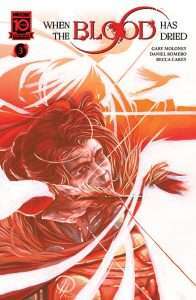 When the Blood Has Dried has, in only three issues, shown itself to be a very relatable fantasy story, one about fresh starts and running from parts of one’s past that one may not find all that pleasant. I found myself rooting for Maebh more and more: she’s fighting for what she’s worked hard for, what she wants to keep, because it gives her purpose, fulfills her. Darius stands in the way of all of that. I was equally impressed to see Darius’s resolve in this matter too; it’s always refreshing to see a villain who is just as determined as the hero to complete their goals, nefarious as they might be. He’s dogged in his pursuit, and it’ll be interesting to see what exactly his plans for the town are.
When the Blood Has Dried has, in only three issues, shown itself to be a very relatable fantasy story, one about fresh starts and running from parts of one’s past that one may not find all that pleasant. I found myself rooting for Maebh more and more: she’s fighting for what she’s worked hard for, what she wants to keep, because it gives her purpose, fulfills her. Darius stands in the way of all of that. I was equally impressed to see Darius’s resolve in this matter too; it’s always refreshing to see a villain who is just as determined as the hero to complete their goals, nefarious as they might be. He’s dogged in his pursuit, and it’ll be interesting to see what exactly his plans for the town are.
From page one, When the Blood Has Dried issue 3 also has some of the most action-packed art in the series so far. Everything is expressive and kinetic; the test of skill near the end of the issue, an archery contest set by Maebh herself, is especially important because it’s so cinematic and expressive. Romero’s art here really shines in those moments.
From the onset, When the Blood Has Dried is pitched as a fantasy story that draws inspiration from spaghetti Westerns, and it’s now that we’re starting to see those elements coming out. It’s easy to draw comparisons between Maebh as the white hat sheriff protecting the town and Darius as the black hat outlaw who comes to take it by force. The archery contest feels like a duel at high noon, with each combatant quick drawing their arrows and shooting almost impossible shots. Issue 3 ends in a cliffhanger, so we’re bound to see more of those elements between Darius and Maebh. The colors in those pages in particular really bring out the Western vibe.
With the fate of Maebh’s tavern – and probably the town itself – in jeopardy, When the Blood Has Dried issue 3 shows that Darius will stop at nothing at nothing to get what he wants, but also that Maebh, intimidated as she might be due to his reappearance, won’t stop until she defends what’s hers. When the Blood Has Dried has shown itself to be a series that continues to impress.
Read When the Blood Has Dried #3The post REVIEW: When the Blood Has Dried #3 by Gary Moloney (W) and Daniel Romero (A) appeared first on Grimdark Magazine.
June 7, 2024
REVIEW: Shadows of Pnath by Josh Reynolds
Shadows of Pnath is the second of the Countess Zorzi novels in the Arkham Horror series. The Arkham Horror series is pretty much what I wish Call of Cthulhu had done with their fiction line decades ago, which is tell a popularized Pulpy adventure series where the investigators have a (small) chance of thwarting the supernatural horrors around them. The Countess Zorzi series is one of the Pulpiest with the Catwoman-esque protagonist and her sidekick, taxi driver Pepper Kelly.
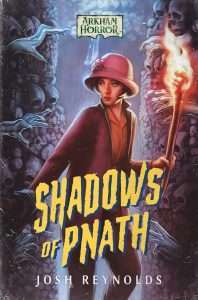 Unfortunately, while the Countess Alessandra Zorzi managed to survive the K’ynan’s vengeance in the previous book, she has left behind a large number of enemies. One of these is the Comte Henri d’Erlette, an former lover with a family history of black magic, who kidnaps Pepper in order to force the Countess to retrieve his copy of Cults des Goules. It turns out the Countess stole it from him and he takes that personally.
Unfortunately, while the Countess Alessandra Zorzi managed to survive the K’ynan’s vengeance in the previous book, she has left behind a large number of enemies. One of these is the Comte Henri d’Erlette, an former lover with a family history of black magic, who kidnaps Pepper in order to force the Countess to retrieve his copy of Cults des Goules. It turns out the Countess stole it from him and he takes that personally.
The Comte is not the only individual who wants the infamous tome, however. The Black Chamber, the RL predecessor agency to the NSA, has gotten into the supernatural occult business. I wondered if this was an homage to Charles Stross’ The Laundry series where that is the United States’ chief cult. If it’s not, though, it’s still a pretty good thing to see the US government stumbling around and trying to cut off the head of the supernatural while having no idea what it requires to do so in the Arkham Horror universe. They’ve also made some extremely poor choices in allies, working with the Silver Twilight Lodge that were the bad guys in The Shadows of Yog-Sothoth campaign and no less nasty here.
Plus, the ghouls themselves have a fairly large role in the story. It turns out they’re not too happy about Cults des Goules publishing the secrets of their race and are willing to kill everyone that Alessandra knows to get it back. This forces Alessandra to track down the client she sold it to and bargain or steal it back. Unfortunately, the kind of people who buy rare occult tomes in the Cthulhu Mythos are far more dangerous than crime bosses or arms trafficker.
I think the book suffers a bit for the fact that Pepper and Alessandra are parted for too long of the story. Much of the series’ success depends on their chemistry between the American working class Pepper and the European aristocrat (fraudulent as she may be). Still, both characters have a lot of good scenes with them. I also appreciated the motivation of the Comte as he isn’t the typical madman trying to summon an Elder God to destroy the world.
We also get the introduction of another secret society in the Red Coterie. These aren’t quite a “good” counterpart to the Silver Twilight Lodge but perhaps a more morally neutral one. I’m not a huge fan of them but I appreciate every entry into the Arkham Horror universe that incorporates new organizations. I hope we see the Brotherhood of the Beast and other classic Chaosium groups get included in future novels.
In conclusion, Shadows of Pnath is a solid sequel to the Wrath of N’Kai. While I enjoyed the previous book more, I think this is entertaining and another good example of Josh Reynolds’ writing style. The books introduce new elements as well as incorporate traditional Lovecraftian ones. I love the Contessa and Pepper so much that I’d read a dozen novels starring them.
Read Shadows of Pnath by Josh ReynoldsThe post REVIEW: Shadows of Pnath by Josh Reynolds appeared first on Grimdark Magazine.
June 6, 2024
REVIEW: The Tigress by Anna Mocikat
The Tigress by Anna Mocikat is the sixth book of the Behind Blue Eyes series. The series is a successful indie cyberpunk drama that follows the tales of a murderous group of sexy antiheroes, specifically the morally conflicted Nephilim. She is a cyborg assassin working for the Olympias Corporation and presently in a relationship with the leader of the Guardian Angels, a death squad that secures the power of the Olympias Corporation over North and South America.
 The previous books established that Metatron, simultaneously villain and love interest of Nephilim, has been plotting to overthrow the Olympias Board of Directors for some time. Having successfully defeated the invasion of Europe’s Rosprom corporation, Olympias has never been more vulnerable while Metatron has never been more powerful. However, to successfully pull off his coup, he needs the other corporation to stand down. The leader of TogbuaXiang, the so-called Tigress, wants to meet with Nephilim and Metatron suspects treachery but it is the only way he can pull off his coup.
The previous books established that Metatron, simultaneously villain and love interest of Nephilim, has been plotting to overthrow the Olympias Board of Directors for some time. Having successfully defeated the invasion of Europe’s Rosprom corporation, Olympias has never been more vulnerable while Metatron has never been more powerful. However, to successfully pull off his coup, he needs the other corporation to stand down. The leader of TogbuaXiang, the so-called Tigress, wants to meet with Nephilim and Metatron suspects treachery but it is the only way he can pull off his coup.
As always, I appreciate any cyberpunk that embraces the dark and sexually charged atmosphere of the genre. Also, the moral ambiguity that defines the peculiar of noir and science fiction at its heart. Characters who were heroes in previous books have fallen to absolute vile levels while villains have started to show their more human qualities. This is particularly notable with former “good guy” Jake, who is completely blind to his own culpability in horrific crimes, while Metatron is starting to see past his previous obsessions.
This book deals with the fallout from the previous ones and manages to develop not just Nephilim but other supporting characters like Jake, Siro, Finwick, and Metatron himself. There’s a lot of humanizing moments and character development that replaces action this time around and I think this is a good decision from the author. In an ongoing series like this, it’s good to follow up big action works like The Last Stand with giving the storyline time to breathe.
I’m not a big fan of the Metatron relationship with Nephilim and still consider it to have been done almost entirely under coercion because he wiped her memory of his actions in the first book. However, it’s interesting to see him finally show some moral revulsion to the behavior of the Board and their own dirty little secrets. While I doubt Behind Blue Eyes will introduce the supernatural at this point in the story, the hints at darker occult undertones aren’t entirely out of place in cyberpunk stories. Mike Pondsmith has done plenty of awesome things with the supernatural and AI after all.
I am also really fond of the way that Jake was treated in the book and his almost serial killer like degeneration to misogyny and violence due to the fact he betrayed everything he believed for Nephilim but had already done unforgivable things to her friends. He’s a wild card now and his toxic relationship with the woman sent to spy on him is fascinating to read about. He may just be projecting a lot of his own self-loathing on her as well. I’m eager to see how that works out as the reversal from hero to villain is now complete.
This book also expands on the portrayal of Asia in the Behind Blue Eyes world. Previous books had given us a look as to how Europe and South America were functioning in the setting but now we know how China and Australia have been changed. While Olympias is shown to be a totalitarian Brave New World-esque hellhole of excess and moral bankruptcy, TogbuaXiang is more, “Like today only worse.” I also like the introduction of the Wasps and their contrast to the Guardian Angels.
In conclusion, The Tigress is another great installment of the Behind Blue Eyes franchise. We’ve got a lot of new developments to the characters and the politics is extremely well handled. While I’d still love for Nephilim to break free from Metatron’s control and go rogue, the story remains consistently interesting and well-written. I’ve yet to read a bad book by Anna Mocikat yet, though.
Read The Tigress by Anna MocikatThe post REVIEW: The Tigress by Anna Mocikat appeared first on Grimdark Magazine.
June 5, 2024
The Road to Redemption by Matthew Ward
More than anything, I love a character with a redemption arc.
I’m not picky. I’ll work on any scale. From Londo Mollari’s galaxy-shaping reversals in Babylon 5 to Javert’s blink-and-you’ll-miss-it change of heart in Les Miserables there’s nothing makes me happier than seeing a lost soul turn back towards the light, if only for a moment. Moreso if they’re not the protagonist (I’m drawn to supporting characters more than the main cast). Especially if there’s no outrunning the consequences hounding their heels.
I know I’m not alone in this. I assume it springs from a desire (conscious or otherwise) for reassurance that we can atone for things that we’ve done in the past, even if they’re nothing more serious than a futzed conversation. Seeing characters grapple with altogether more serious lapses and still find a brief measure of peace in the striving has to be reassuring, right?
On another level, I think we’re drawn to these doomed souls simply because you can’t have a satisfying redemption arc without decent characterisation. They have to feel real for any of the story beats to land. They have to be sympathetic – if only a little – for you to care whether they manage to walk towards the light, despite all the darkness dragging them down. Don’t hate the player, hate the game, and all that.
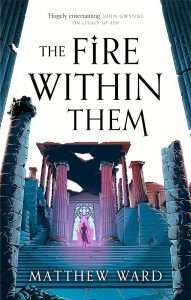 Even knowing all this, I’m still surprised at just how many redemptive character arcs trickle into my books. The Legacy Trilogy has a bunch, some playing out over a single book whereas at least one runs the length of the entire story, complete with wobbles along the way. The Soulfire Saga probably has more, despite its smaller cast … and the gears on a couple really start to grind in The Fire Within Them (out June 11th).
Even knowing all this, I’m still surprised at just how many redemptive character arcs trickle into my books. The Legacy Trilogy has a bunch, some playing out over a single book whereas at least one runs the length of the entire story, complete with wobbles along the way. The Soulfire Saga probably has more, despite its smaller cast … and the gears on a couple really start to grind in The Fire Within Them (out June 11th).
So, what have I learnt along the way? Let’s talk about that. Bear in mind that I’m mostly talking about redemption for supporting characters (because they’re my favourite) but the rules still apply to protagonists, gallant or otherwise.
You’ve Got to CareAs mentioned above, it’s no good if you don’t like the redemption seeker. It’s simply not enough for them to chase atonement because it’ll help the protagonist get ahead and keep the plot on course. You have to long for them to acknowledge their mistakes and embrace change. Hopelessly romantic? Maybe, but even the darkest story benefits from emotional contrast. Despite his toxically ironclad dedication to his duty, Javert from Les Mis is an honourable man. Babylon 5’s Londo is a genuinely likeable, down on his luck rogue who badly wants to be liked.
Missed OpportunitiesJust as protagonists mostly (but not always) need to reject the call to stand up and be counted for a satisfying story, so too does the redemption seeker need to be a bit sluggish out of the gate. After all, they wouldn’t need redemption if they had the nous to simply do the right thing from the very start. This can be anything from a full-fledged betrayal through to simply refusing to help at a vital moment.
As long as it feels like a natural progression of the character, the possibilities are endless … although of course the deeper the pit they dig, the longer the ladder they’re going to need to clamber back out. Think about Javert. In all versions of Les Mis, he has plenty of opportunities to let the clearly virtuous Jean Valjean escape his past, but initially can’t unbend enough to do so. Babylon 5’s Londo has so many chances to turn aside from his dark path but still does horrific things out of fear and ambition. If you listen closely, you can hear the audience screaming at him to stop.
SacrificeRedemption has to hurt for it to have value. The more terrible the character’s deeds, the greater the pain. It’s not just the karmic balance for the redemption seeker themselves that matters, but evening up the balance within the storyline. Go too light on the redemption seeker and it’ll cheapen what (should) be a pivotal turning point in the story.
Londo Mollari is warned long before the end that his only hope for redemption is to surrender to his greatest fear, knowing that it will destroy him. By the time he really embraces atonement, the audience has a pretty good idea of what that’s going to mean – even Londo doesn’t – making his turn towards the light that much more poignant. Javert’s sacrifice is more immediate. Though he knows he’s done the right thing by finally abandoning his pursuit of Valjean, he can’t reconcile his actions with his duties and becomes his own executioner.
(And because I know I’m writing this for Grimdark Magazine) Redemption Can’t be CertainEven when a redemption seeker’s finally done the right thing, the rest of the characters (or even the world) have no obligation to think better of them. Friends might be glad that they came through in the end. Others might actively hate them all the more for all those pesky missed opportunities. Some can even remain cheerfully ignorant that a sacrifice ever took place.
Sometimes the worst punishment is to throw your life away and for no one even to notice. It’s not fair, maybe, but who said life had to be?
I mean, until it’s gone midnight and you can’t sleep, and every questionable decision you’ve ever made comes crawling out of your brain to circle around your thoughts in a cackling chorus line. Just me? Fine. Be like that. Lie to yourself.
With a wonderful singing voice if it’s the musical version. That ain’t nothing.
No pressure, mate.
Or moodily, because Grimdark.
Read The Fire Within Them by Matthew WardThe post The Road to Redemption by Matthew Ward appeared first on Grimdark Magazine.
June 4, 2024
REVIEW: Tears of Raphaela by Richard Swan
In Tears of Raphaela by Richard Swan, a new Warhammer 40,000 short story from Black Library, Brother Ramethos of the Lamenters space marine chapter hunts the last Tyranid Prime across the devoured cities of the planet Raphaela. With his sniper bolt rifle and three remaining executioner rounds he can destroy the horde’s synaptic link to their last leader and end their domination.
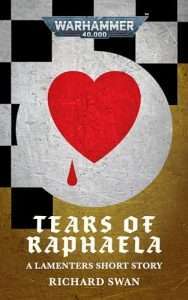
In Tears of Raphaela, we get another look into the Tyranid invasion we first read in Blood Harvest, this time from the elite space marines’ perspective. I loved the way Swan showcased that even the super human space marines and their ancient power armour could fall and start rotting in the miasma of a world where the Tyranid bio forms had devoured everything and poisoned the very air with their carnivorous spores.
As Ramethos chases the Prime we are shown a vision of a world where the mighty and many have fallen beneath the teeth and claws of the innumerous, and every act of heroism from the smallest Astra Militarium soldier to the mightiest space marine is forgotten in the eyes of the universe, but for one lone space marine to lament their passing.
What makes Tears of Raphaela a fun read is that it creates a feeling of constant movement and action, without resorting to it being one long battle scene. I also really liked the play on the bad luck of the Lamenters chapter—something I didn’t previously know and that I think, for this reader at least, added a tiny bit of humour.
One of the things I love about Black Library is their focus on creating ongoing stories with retained characters (If you’d like a starting point for some of their best series, check out Warhammer 40k: Where to Start Reading) who you cheer for (and sometimes maybe cry a bit for) as their bloody, brutal lives are portrayed on the page (and soon on screen!). With Blood Harvest and Tears of Raphaela, it feels like Swan has taken the first two steps towards creating a Lamenters versus Tyranids playpen for stories of might heroism and all-hope-lost moments against the never-ending horde of Tyranids, and I can’t wait for more.
Make sure you grab this quick, 20 minute read full of non-stop action.
Read Tears of Raphaela by Richard SwanThe post REVIEW: Tears of Raphaela by Richard Swan appeared first on Grimdark Magazine.
June 3, 2024
REVIEW: The Fire Within Them by Matthew Ward
In The Fire Within Them by Matthew Ward, Kat’s story of survival, rebellion, and love and loss that I enjoyed so much in The Darkness Before Them continues. These main themes remain in book two, with strong new themes of duty and redemption playing key parts. Ward has also done something I absolutely love in fiction, turning secondary characters into primary characters and using those people to explore more of the world he has created in book one of The Soulfire Saga as we follow Kat and her crew trying to overthrow an undead king who has the people of Khalad firmly beneath his fiery boot heel.
Before you continue reading about The Fire Within Them, be wary that this review contains one key spoiler for book one.
 In The Fire Within Them, Kat tries to save her mother from her father, boarding a land train to stop her mum from being shipped to a quiet little outpost and killed so her father could play the grieving lord and move on with his life. And she must do so without her tattoo to manipulate the spirits around her while her body begins to betray her. In the attempt, she discovers her sister is not as claimed by the Deadwinds as she first thought …
In The Fire Within Them, Kat tries to save her mother from her father, boarding a land train to stop her mum from being shipped to a quiet little outpost and killed so her father could play the grieving lord and move on with his life. And she must do so without her tattoo to manipulate the spirits around her while her body begins to betray her. In the attempt, she discovers her sister is not as claimed by the Deadwinds as she first thought …
Damant accompanies Rima, his ageing warrior diplomat character an interesting juxtaposition against a warrior a hundred thousand years old being stalked by the only killer Damant ever witnessed capable to standing against Rima’s sword and preternatural combat abilities.
Vanquished villain in The Darkness Before Them, Tanith is a powerful demon-infused character trying to figure her life out after being released by the Deadwinds, rejected again by her parents, and finding that while she’s certain her sister Kat should be punished, she’s not quite sure she should kill her anymore. All the while Tanith’s hunger to devour souls drives her every moment. For the grimdark fan, Tanith is the character most likely to hit your morally grey sweet spot as she finds a person capable–and willing–to help her … for a price.
Each of the POVs in The Fire Within Them lends significant weight to the reading experience. Kat and Tanith’s stories are the key foundation of the book, as Kat tries to save her mother and Tanith tries to save herself, and they both try to figure out how to be with each other. Kat retains her crew from the first book with Vallant and Yali still in play, and one previous character coming back into her life who she must decide if she’ll allow to return. Tanith is betrayed by everyone she knows. She is alone, and angry. And she is also desperate. A father figure finds her and gives her purpose, gives her a cause to get behind and teaches her how to control her hunger so she may be of use to his uprising.
A character who is given significant screen time through the eyes of Damant, is Rima. She is a mystery in book one, but gets a far more fleshed out story line in book two as Rima and Damant delve into the darkness below to face the calling of her grandfather and her people. Damant’s storyline is more about witnessing Rima’s life and tribulations than about his perspective, which I quite enjoyed as an approach to storytelling. There’s a part of me that wishes we didn’t unveil as much of Rima as we did in the book, as I quite enjoyed the mystery of her and the alienness of her character in The Darkness Before Them, but it was necessary for the expansion of the story into what I would deem a more epic lens, and for her partnership with Damant to have depth.
Ward really expands the world in The Fire Within Them. We jump into the world’s myth and legend brought to life with both feet. One of the key ways Ward does this is by leaning into the religion: its god, its story, and what the reality looks like versus the myths. If you wanted to know more about Nyssa, the Eternity King, and The Voice then buckle up for a trip to The Stars Below. The Stars Below gives us a view into one of the long lost layers of Khalad and looks past the lore known to our characters. This more religiously exploratory story aspect I quite enjoyed in some parts, and had to back track and re-read to make sure I understood in others.
The Fire Within Them is still stacked full of ifrit (people’s souls used to create movement and fire as part of trains, carts, guns, and lamps), and there’s plenty more of the terrifying undead koilos creatures. The feeling of the cities in this world being a bit like the hive cities of the Warhammer 40,000 universe remains, especially with the exploration of The Stars Below, and there is a general consistent claustrophobic feel to the story as we get deeper into the book that I think fans of that universe would enjoy.
The Fire Within Them ramps up the insights into this world by peeling back multiple layers of lore to give us a peek at the fiery underbelly. I didn’t enjoy this as much as The Darkness Before Them, but it was still an epic dark fantasy read with plenty for grimdark fans to stick their teeth into. Having seen Ward’s ability to bring home a series with his Legacy trilogy (Legacy of Ash, Legacy of Steel, Legacy of Light) I highly recommend picking up these books. I think book three will be a cracker.
Read The Fire Within Them by Matthew WardThe post REVIEW: The Fire Within Them by Matthew Ward appeared first on Grimdark Magazine.
June 2, 2024
REVIEW: Riven Earth by Zammar Ahmer
Nature and humanity clash in Zammar Ahmer’s Riven Earth, a breathtakingly epic yet intimately character-driven grimdark fantasy that will sink its roots into the hearts of everyone who loves a good dose of heavy emotional destruction with their fantastical adventures.
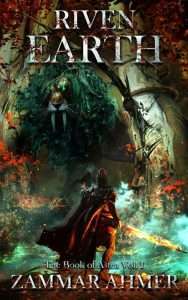 Twelve years ago, the unconquerable dryad empire was brought to ash to make place for the Kingdom of Heartsong. But a kingdom forged in blood will have to pay the price of its brutal creation, and now nature is demanding its due. The earth is trembling, famine razes through the lands, and a mysterious blood sickness is threatening all of humanity. But as treason thrives and war looms ever closer, the most dangerous tempests might just be the ones ravaging everyone’s minds from within.
Twelve years ago, the unconquerable dryad empire was brought to ash to make place for the Kingdom of Heartsong. But a kingdom forged in blood will have to pay the price of its brutal creation, and now nature is demanding its due. The earth is trembling, famine razes through the lands, and a mysterious blood sickness is threatening all of humanity. But as treason thrives and war looms ever closer, the most dangerous tempests might just be the ones ravaging everyone’s minds from within.
Now, I challenge you to read the prologue to Riven Earth and try to put the book down after that. Spoiler alert, you won’t be able to. This story is honestly straight-up fire from the very first page (pun intended, iykyk), and Ahmer’s wild imagination and mesmerising prose just continues to amaze and spark wonder all the way through.
We are transported into a world not dissimilar to the one in Mark Lawrence’s Book of the Ancestor, where only one strip of land is still somewhat habitable, though not without risk. In a way, the world almost feels like a character in its own, which I personally really loved. The entire flora and fauna of this world was just so incredibly imaginative and fascinating, brimming with malicious earthly forces, diverse races and fantastical creatures, dryad and sun-based magic, and a plethora of immersive settings that are brought to life through the most breathtaking descriptions.
Though while Riven Earth shines in many aspects, it was Ahmer’s terrifyingly realistic and intimate character work that captivated me the most. We follow a diverse and dynamic cast of characters who are scattered all across the spectrum of gray morality, and they each just leap off the page with personality, for better or worse. A young king crippled by depression and his desperate yet supportive wife, an advisor struggling with her burdens and fed up with everyone’s bullshit, a ruthless politician who is way too conniving and ambitious for his own good, and a grieving, terminally ill soldier who stumbles into becoming a reluctant hero in his final days; each of these characters is established with an Abercromie-like skill of characterisation, bringing them to life through their uniquely distinct inner voices and dangerously sharp dialogue.
And not only does this epic and sprawling story remain rooted through the intimate narration of these characters, but the themes and conflicts are also presented with so much nuance and ambiguity through their opposing perspectives. Riven Earth can definitely be a mentally and emotionally challenging read at times, especially when being in the heads of the more prejudiced and depraved characters, but I personally think Ahmer handled the darker and more disturbing content with exceptional skill.
Broader themes of racism, genocide, religious zealotry, corruption, and rewriting of history are beautifully balanced with the more intimately vulnerable themes of mental health (in men), depression, suicidal ideation, grief, and the dangerously thin line between hate and love, which is exactly what makes this story so rich and emotionally impactful. Moreover, I was pleasantly surprised to see some powerful women and casually queer people represented here, especially in a world where prejudice runs rampant in other regards.
Every aspect of Riven Earth is just beautifully in harmony with each other, and each new revelation helps build tension as it recontextualizes everything you thought you knew about this world and its characters in the most satisfying way imaginable. I do have to say that the unpredictable inclusion of sudden flashbacks made for a slightly rocky pacing and somewhat unclear chronology of events, but at the same time I loved how those insights into the history of the world and backstory of these characters only made everything feel more fleshed out and complex.
Safe to say, Riven Earth kicks off The Book of Astea duology with an absolute bang, and the brutal yet enticing ending practically demands the reader to come back for the sequel. Which, fortunately for all of us, is already written and is scheduled to be released within a month (July 2024); that’s indie winning the game for you, just saying.
With a debut that is this astonishingly strong, Ahmer immediately proves that he is absolutely an author to be watched. Fans of Joe Abercrombie, Mark Lawrence, and Thiago Abdalla will find much to love in this gritty yet emotional grimdark fantasy, though it also offers an altogether more unique reading experience that will surprise and thrill with each new imaginative concept and shocking twist and turn. I simply can’t recommend Riven Earth highly enough, not only because it is a truly exceptional story, but also because I selfishly need more people in my fanclub/emotional support group, thank you very much!
Thank you to the author for providing me with an eARC in exchange for an honest review. All opinions are my own. Riven Earth is scheduled for release on June 11th, 2024.
The post REVIEW: Riven Earth by Zammar Ahmer appeared first on Grimdark Magazine.
June 1, 2024
REVIEW: Conan the Barbarian #11 by Jim Zub (W) and Roberto De La Torre (A)
At the conclusion of Conan the Barbarian issue #10, Kull led Conan, Brule, and the Red Slayers to his homeland in Atlantis, only to find that the village of his birth has been replaced by a yawning abyss. As the party descends into the chasm, Conan flashes back to his conversation with Yag-Kosha (in Conan the Barbarian issue #9), a pachyderm-headed alien god who he slayed a decade ago in his own life (during the events of the 1933 Robert E. Howard story “The Tower of the Elephant”), yet encountered alive and well just days ago in Valusia. Yag-Kosha emphasizes that Conan’s soul has been “set adrift” in time, but that his fate is entwined with Brissa, a Pictish warrior woman from his own era (missing and presumed dead as of the conclusion of Conan the Barbarian issue #4) and her distant ancestor Brule.
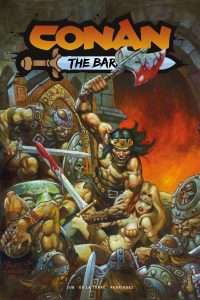 Upon reaching the bottom of the pit, Conan and Kull discover a series of ancient cyclopean chambers that—judging from the arms and armor left behind—appear to have once been inhabited by giants. The situation quickly becomes deadly as the explorers inadvertently release a horde of hostile subhuman creatures. Even accompanied by the elite Red Slayers, Kull and his companions face a difficult struggle.
Upon reaching the bottom of the pit, Conan and Kull discover a series of ancient cyclopean chambers that—judging from the arms and armor left behind—appear to have once been inhabited by giants. The situation quickly becomes deadly as the explorers inadvertently release a horde of hostile subhuman creatures. Even accompanied by the elite Red Slayers, Kull and his companions face a difficult struggle.
Rob De La Torre’s artwork is a visual feast, as always. His John Buscema-inspired character artwork and dynamically staged combat scenes receive a great deal of justified praise, but his backgrounds are also worthy of attention. His oppressive monolithic architecture and craggy, menace-filled subterranean passages create a real sense of place for the events of the story. Diego Rodriguez’s color work in this issue was also effective. Whether an intentional reference or not, the bluish-white coloration of the subterranean attackers brought to mind the Morlocks from the 1960 film adaptation of H.G. Wells’ The Time Machine.
Jim Zub’s storytelling continues to excite, with the issue’s climax leaving this reader full of questions and wanting more. The flashback to Conan’s conversation with Yag-Kosha felt a little lengthy and redundant, however. By this point it should be abundantly clear to both the reader and Conan himself that the barbarian is outside of his natural place in time and space. Additional, talk of “fate” and “destiny” in Conan pastiche never sits well with me. While there was occasional foreshadowing in the Howard stories that Conan would one day become a king, I’ve never had the sense that outside forces were in play or that his claiming the throne was in any way preordained. Much of the appeal of Conan is that he is a self-made hero who uses his wits, skills, and physique to accomplish his objectives. He’s no “chosen one”; Conan forges his own destiny.
On the other hand, while Howard purists may balk, I appreciate that Zub has been incorporating elements of the 1982 Conan the Barbarian film into the comic. While originally created by Howard as an antagonist for King Kull, Thulsa Doom was the memorable movie villain and has been an “off-screen” presence in this comic since the first story arc. Movie fans will also doubtless appreciate the appearance in this issue of a certain instantly recognizable sword.
This issue features not one but two essays by Robert E. Howard expert Jeffrey Shanks. The first goes into detail about Thulsa Doom. In addition to listing Thulsa Doom’s appearances across Howard’s body of work, Shanks also suggests that the skull-headed sorcerer was an inspiration for both the lich monster in Dungeons & Dragons and Skeletor from the Masters of the Universe franchise. The second, briefer essay examines the Nemedian Chronicles epigraph (i.e., “Hither came Conan…”) that accompanied Conan’s debut in “The Phoenix on the Sword” (1932) and has been a popular inclusion in Conan films, comics, and novels ever since. The premise of the essay boils down to “Some versions of the quotation begin with ‘Know, oh prince…’ and others ‘Know, O prince…’; which is correct?” This sort of pedantry is real “inside baseball” stuff, unlikely to be noticed or remarked upon by any but the most hardcore Conan fan, but the essay both informed me and made me grin.
With Conan the Barbarian issue #11, Zub has laid the groundwork for an epic showdown with the potential for repercussions throughout both the Thurian Age and Conan’s own distant Hyborian Age. While it feels like there may be too much plot remaining to neatly resolve in a single issue, I look forward to seeing where Zub takes us.
Read Conan the Barbarian #11 by Jim Zub (W) and Roberto De La Torre (A)The post REVIEW: Conan the Barbarian #11 by Jim Zub (W) and Roberto De La Torre (A) appeared first on Grimdark Magazine.

 Read on Amazon
Read on Amazon

